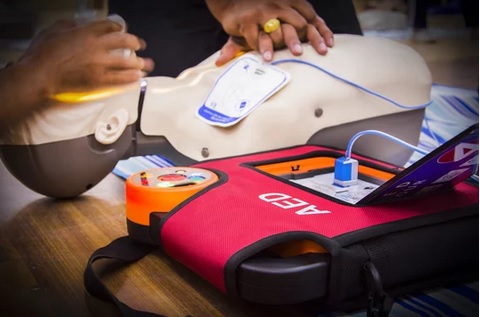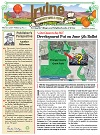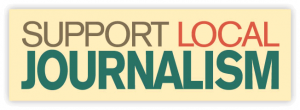 On January 2nd, NFL football player Damar Hamlin suffered a sudden cardiac arrest on the field after a tackle during the Bills-Bengals NFL game. The working diagnosis suggested was commotio cordis, caused by a sudden violent impact to his chest. This is just one cause of sudden cardiac arrest.
On January 2nd, NFL football player Damar Hamlin suffered a sudden cardiac arrest on the field after a tackle during the Bills-Bengals NFL game. The working diagnosis suggested was commotio cordis, caused by a sudden violent impact to his chest. This is just one cause of sudden cardiac arrest.
Damar Hamlin was saved by a well-trained medical team and certified athletic trainers who: 1) recognized the cardiac arrest; 2) immediately initiated CPR; 3) used the AED (automated external defibrillator) to restore his heart rhythm; and 4) had Emergency Medical Responders transport him to a Level 1 trauma center.
If this had happened to one of our Irvine youth or adult recreational sports players, are we confident that the individual would have had the same life-savings emergency medical treatment that Hamlin had and was able to be discharged from the hospital in just nine days?
 Hamlin’s injury brought back memories of my own experience as a pediatric resident covering the intensive care unit at UCI decades ago. My 15-year-old patient was tackled at the Friday night high school football game. He got up, walked to the sideline, and then collapsed and later died.
Hamlin’s injury brought back memories of my own experience as a pediatric resident covering the intensive care unit at UCI decades ago. My 15-year-old patient was tackled at the Friday night high school football game. He got up, walked to the sideline, and then collapsed and later died.
I always wondered if a more experienced onsite medical team with a practiced emergency plan could have saved his life. Would he have lived had this occurred today with new and better life-saving technology and an outstanding Orange County Emergency Medical Response (EMS) team?
Hamlin’s injury also reminded me of a more recent incident when here in Irvine, our softball team pitcher took a line drive to his face. The AED was locked in the clubhouse. The umpire did not have a key and clearly was not trained to respond to the emergency. Ultimately, our teammate got the care he needed. But, the incident revealed a real lack of preparedness on the part of the City.
In another instance, our granddaughter witnessed the sudden cardiac arrest of a student at her school. Thankfully, the school nurse happened to be in the administrative office just at the right time. She resuscitated the student using the AED before the EMS team arrived. What would have happened if the well-trained school nurse had not been scheduled to be at that school that day? (We currently do not have a school nurse onsite at each Irvine school.)
In the wake of Damar Hamlin’s injury, we need to use this window of opportunity to assess and improve our City’s capacity to respond to youth and adult sports injuries.
We should be asking if our community services staff, coaches, trainers, teachers, and parents are adequately prepared to handle emergencies, even though they are rare. Are AEDs readily available, in good working order, and do we know how to use them? Can we reassure ourselves that we are doing all we can to promote youth sports participation as safely as possible?
Here is what Irvine resident, and member of the Irvine Children, Youth and Families Strategic Plan Advisory Committee, Ameer Mody, MD, MPH* said: “The response to Damar Hamlin’s life-threatening injury was a blessing. A blessing that there was a quick response from a well-equipped, well-trained team. This is a call to action for community CPR training. The initial steps in a resuscitation like this can be performed by community members trained in CPR and AED use until emergency medical personnel arrive.”
In response to Dr. Mody’s call to action, we are recommending that City staff assess our capacity to respond to sudden cardiac arrest and other life-threatening emergencies — including traumatic injuries, drug overdose, and suicide risk. Based on that assessment, we could develop an innovative plan to enhance and maintain our emergency response plans for youth sports injuries. The Irvine Children, Youth and Families Strategic Plan Advisory Committee is participating in a COVID-19 era update to the plan. Community emergency preparedness could become part of that plan.
While the focus of this article is on youth sports injuries, the recommendations apply beyond youth and beyond just sports injuries, but rather our ability to save a life, at any time and in any setting.
“All citizens of the world can save a life … and that, to do this, you only need two hands.” That’s the Restart a Heart message of the Global Resuscitation Alliance World.
Resource Links
Global Resuscitation Alliance.
The American Academy of Pediatrics Policy Statement on Sudden Death from Cardiac Arrest in the Young
Preparing for Sudden Cardiac Arrest in Schools
*Ameer P. Mody, MD MPH FAAP (Fellow of the American Academy of Pediatrics)
Associate Division Director, Pediatric Emergency Medicine
Director of Emergency Department Clinical Informatics
Division of Emergency and Transport Medicine | Children’s Hospital Los Angeles
Clinical Associate Professor of Pediatrics (Clinician-Educator) | USC Keck School of Medicine
- Keeping Your Family Safe This Pool Season - June 26, 2024
- Keeping Kids Safe On & Off the Baseball Field - May 31, 2024
- Are Electric Bikes (E-Bikes) Safe? - March 7, 2024



